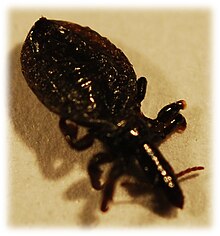Haematopinus
| Haematopinus | |
|---|---|

| |
| Haematopinus apri | |
| Scientific classification | |
| Kingdom: | |
| Phylum: | |
| Class: | |
| Order: | |
| Suborder: | |
| Family: | Haematopinidae Enderlein, 1904
|
| Genus: | Haematopinus Leach, 1815
|
| Species | |
|
see text | |
Haematopinus is a genus of insects in the suborder Anoplura, the sucking lice. It is the only genus in the family Haematopinidae,[1] known commonly as the ungulate lice.[2] All known species are of importance in veterinary medicine.[1] These lice are some of the worst ectoparasites of domestic animals.[3] Species infest many domesticated and wild large mammals, including cattle, horses, donkeys, swine, water buffalo, African buffalo, antelope, zebra, deer, and camels.[3]
Species include:[4]
- Haematopinus acuticeps
- Haematopinus apri
- Haematopinus asini – horse sucking louse
- Haematopinus breviculus
- Haematopinus bufali
- Haematopinus channabasavannai
- Haematopinus eurysternus – shortnosed cattle louse
- Haematopinus gorgonis
- Haematopinus jeannereti
- Haematopinus latus
- Haematopinus longus
- Haematopinus ludwigi
- Haematopinus meinertzhageni
- Haematopinus nigricantis
- Haematopinus oliveri – pygmy hog sucking louse
- Haematopinus oryx
- Haematopinus phacochoeri
- Haematopinus quadripertusus – cattle tail louse
- Haematopinus suis – hog louse
- Haematopinus taurotragi
- Haematopinus tuberculatus
References
- ^ a b Scofield, A., et al. (2012). Infestation by Haematopinus quadripertusus on cattle in São Domingos do Capim, state of Pará, Brazil. Revista Brasileira de Parasitologia Veterinária 21(3), 315-18.
- ^ Haematopinidae (ungulate lice). Uniprot.
- ^ a b Meleney, W. P. and K. C. Kim. (1974). A comparative study of cattle-infesting Haematopinus, with redescription of H. quadripertusus Fahrenholz, 1916 (Anoplura: Haematopinidae). The Journal of Parasitology 60(3), 507-22.
- ^ Haematopinus. Integrated Taxonomic Information System (ITIS).
